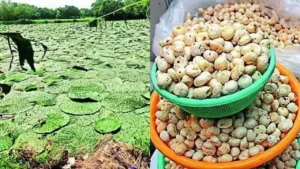GS III-Agriculture

Makhana, also known as Foxnut, is a significant aquatic crop cultivated primarily in stagnant perennial water bodies such as ponds, ditches, swamps, oxbow lakes, and land depressions. It thrives in tropical and subtropical climates and holds substantial cultural, economic, and nutritional importance.
Origin and Distribution:
Though native to South-East Asia and China, Makhana is now grown in various parts of the world. In India, it is primarily cultivated in the states of Bihar, West Bengal, Assam, Manipur, Tripura, Jammu & Kashmir, Odisha, Rajasthan, Madhya Pradesh, and Uttar Pradesh, though commercial-scale production is concentrated in a few regions.
- Bihar stands out as the leading producer, contributing over 80% of India’s total Makhana output. The state is also a hub for its processing and value addition.
Climatic & Soil Requirements:
- Temperature: 20°C to 35°C
- Relative Humidity: 50% to 90%
- Annual Rainfall: 100 cm to 250 cm
- Soil: Prefers smooth loamy soil that retains moisture but does not waterlog excessively.
Government Support:
Makhana has been recognized under the “One District One Product (ODOP)” scheme by the Union Government. This initiative facilitates:
- Subsidies for infrastructure development
- Support in branding and marketing
- Encouragement for food processing industries
Benefits of Makhana:
- Dual Use – Food & Medicine: Makhana is a hydrophyte that serves both nutritional and therapeutic purposes.
- In traditional Chinese medicine, it has long been used for its health-boosting properties.
- It is rich in nutrients, supports digestive health, and possesses various medicinal attributes.
- As a cash crop, it offers significant economic benefits, especially for small and marginal farmers in waterlogged and flood-prone areas.




